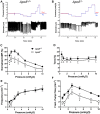Multiple aspects of lymphatic dysfunction in an ApoE -/- mouse model of hypercholesterolemia
- PMID: 36685213
- PMCID: PMC9852907
- DOI: 10.3389/fphys.2022.1098408
Multiple aspects of lymphatic dysfunction in an ApoE -/- mouse model of hypercholesterolemia
Abstract
Introduction: Rodent models of cardiovascular disease have uncovered various types of lymphatic vessel dysfunction that occur in association with atherosclerosis, type II diabetes and obesity. Previously, we presented in vivo evidence for impaired lymphatic drainage in apolipoprotein E null (ApoE -/- ) mice fed a high fat diet (HFD). Whether this impairment relates to the dysfunction of collecting lymphatics remains an open question. The ApoE -/- mouse is a well-established model of cardiovascular disease, in which a diet rich in fat and cholesterol on an ApoE deficient background accelerates the development of hypercholesteremia, atherosclerotic plaques and inflammation of the skin and other tissues. Here, we investigated various aspects of lymphatic function using ex vivo tests of collecting lymphatic vessels from ApoE +/+ or ApoE -/- mice fed a HFD. Methods: Popliteal collectors were excised from either strain and studied under defined conditions in which we could quantify changes in lymphatic contractile strength, lymph pump output, secondary valve function, and collecting vessel permeability. Results: Our results show that all these aspects of lymphatic vessel function are altered in deleterious ways in this model of hypercholesterolemia. Discussion: These findings extend previous in vivo observations suggesting significant dysfunction of lymphatic endothelial cells and smooth muscle cells from collecting vessels in association with a HFD on an ApoE-deficient background. An implication of our study is that collecting vessel dysfunction in this context may negatively impact the removal of cholesterol by the lymphatic system from the skin and the arterial wall and thereby exacerbate the progression and/or severity of atherosclerosis and associated inflammation.
Keywords: back-leak; contractile dysfunction; high fat diet; lymphatic endothelium; lymphatic muscle; lymphatic valve; permeability; pump limit.
Copyright © 2023 Davis, Scallan, Castorena-Gonzalez, Kim, Ying, Pin and Angeli.
Conflict of interest statement
The authors declare that the research was conducted in the absence of any commercial or financial relationships that could be construed as a potential conflict of interest.
Figures






Similar articles
-
Lymphatic Valve Dysfunction in Western Diet-Fed Mice: New Insights Into Obesity-Induced Lymphedema.Front Pharmacol. 2022 Mar 4;13:823266. doi: 10.3389/fphar.2022.823266. eCollection 2022. Front Pharmacol. 2022. PMID: 35308249 Free PMC article.
-
Chronic high-fat diet impairs collecting lymphatic vessel function in mice.PLoS One. 2014 Apr 8;9(4):e94713. doi: 10.1371/journal.pone.0094713. eCollection 2014. PLoS One. 2014. PMID: 24714646 Free PMC article.
-
Dietary quercetin attenuates oxidant-induced endothelial dysfunction and atherosclerosis in apolipoprotein E knockout mice fed a high-fat diet: a critical role for heme oxygenase-1.Free Radic Biol Med. 2013 Dec;65:908-915. doi: 10.1016/j.freeradbiomed.2013.08.185. Epub 2013 Sep 7. Free Radic Biol Med. 2013. PMID: 24017971
-
Lymphatic vessels of the eye - old questions - new insights.Ann Anat. 2019 Jan;221:1-16. doi: 10.1016/j.aanat.2018.08.004. Epub 2018 Sep 18. Ann Anat. 2019. PMID: 30240907 Review.
-
Mechanical forces and lymphatic transport.Microvasc Res. 2014 Nov;96:46-54. doi: 10.1016/j.mvr.2014.07.013. Epub 2014 Aug 5. Microvasc Res. 2014. PMID: 25107458 Free PMC article. Review.
Cited by
-
Reply to: "Prophylactic Lymphovenous Bypass for Breast Cancer-Related Lymphedema: Research Challenges, Statistical Pitfalls, and Solutions".Ann Surg Oncol. 2025 Aug;32(8):5847-5848. doi: 10.1245/s10434-025-17377-8. Epub 2025 May 2. Ann Surg Oncol. 2025. PMID: 40314903 No abstract available.
-
Developmental progression of lymphatic valve morphology and function.Front Cell Dev Biol. 2024 Feb 21;12:1331291. doi: 10.3389/fcell.2024.1331291. eCollection 2024. Front Cell Dev Biol. 2024. PMID: 38450249 Free PMC article.
-
Acute Metabolic Stress Induces Lymphatic Dysfunction Through KATP Channel Activation.Function (Oxf). 2024 Sep 10;5(5):zqae033. doi: 10.1093/function/zqae033. Function (Oxf). 2024. PMID: 39075985 Free PMC article.
-
Connexin-45 is expressed in mouse lymphatic endothelium and required for lymphatic valve function.JCI Insight. 2024 Jul 18;9(16):e169931. doi: 10.1172/jci.insight.169931. JCI Insight. 2024. PMID: 39074069 Free PMC article.
-
Protective role of Pannexin1 in lymphatic endothelial cells in the progression of atherosclerosis in female mice.PLoS One. 2024 Dec 30;19(12):e0315511. doi: 10.1371/journal.pone.0315511. eCollection 2024. PLoS One. 2024. PMID: 39775604 Free PMC article.
References
-
- Agabiti-Rosei C., Paini A., De Ciuceis C., Withers S., Greenstein A., Heagerty A. M., et al. (2018). Modulation of vascular reactivity by perivascular adipose tissue (PVAT). Curr. Hypertens. Rep. 20, 44. - PubMed
-
- Berendam S. J., Koeppel A. F., Godfrey N. R., Rouhani S. J., Woods A. N., Rodriguez A. B., et al. (2019). Comparative transcriptomic analysis identifies a range of immunologically related functional elaborations of lymph node associated lymphatic and blood endothelial cells. Front. Immunol. 10, 816. 10.3389/fimmu.2019.00816 - DOI - PMC - PubMed
Grants and funding
LinkOut - more resources
Full Text Sources
Miscellaneous

